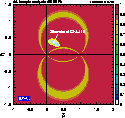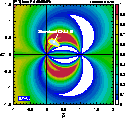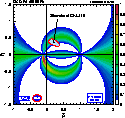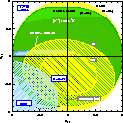CKM Constraints from Charmless B Decays
We present a combined CKMfitter analysis using branching ratios (BR) and direct CP-violating asymmetries in B --> pipi, Kpi decays and time-dependent CP asymmetries in B --> pipi.
In general, the constraints are presented in the parameter spaces (rhobar,etabar), the unitarity triangle angle alpha, the plane spanned by the observed coefficients of the sine and the cosine terms, (Spipi,Cpipi), as well as the relative strong phase vs. the penguin-to-tree ratio, (|P/T|,delta). It is the goal of the latter two representations to test theoretical approaches used to describe the dynamical structure of the transition amplitudes. A priori knowledge on the CKM phase, obtained from the standard CKM analysis is injected into these fits, either for comparison purposes, or as direct input to predict experimentally accessible observables or theoretical quantities.
We approach the problem following the hierarchical structure outlined below:
- using as input Spipi and Cpipi as well the BR(B --> pipi) (all charges) and strong isospin symmetry SU(2) and neglecting electro-weak penguins.
- using I. and B0 --> K+pi- together with SU(3) flavour symmetry and neglecting OZI-suppressed penguin annihilation topologies.
- using I. and a phenomenological estimate of |P| by means of the decay rate of B+ --> K0pi+. The relative strong phase is unconstrained in this approach.
- using I. and the prediction of the complex penguin-to-tree ratio, that is |P/T| and its phase, predicted by QCD Factorisation (BBNS).
Details about the analysis can be found in this preprint.
- The theoretical description of hadronic charmless B-decays is under
ongoing discussions.
Therefore, one should consider these fits as R&D studies
when discussing confidence levels. As a consequence, all plots are
marked by an appropriate R&D logo:
- # world average B --> pipi,Kpi branching fractions (BABAR, Belle and CLEO [1][2][3]).
# values of Cpipi and Spipi from BABAR and Belle.
# for the standard CKM fit see the input page and hep-ph/0104062.
| Constraints on the branching fraction B0 --> pi0pi0 obtained from the measurements of B0 --> pi+pi-, B+ --> pi+pi0, B- --> pi-pi0 and Cpipi using the isospin relations (preprint). Given by the hatched area is the prediction from QCD FA: larger BR(B0 --> pi0pi0) require larger values of the unitarity triangle angle alpha. The upper plot uses Cpipi from BABAR, the lower plot uses Cpipi from Belle. The vertical arrow indicates the experimental upper limit at 90% CL found by BABAR. The horizontal arrows indicate the zone for which the CL is equal or better than 10%. |
|






